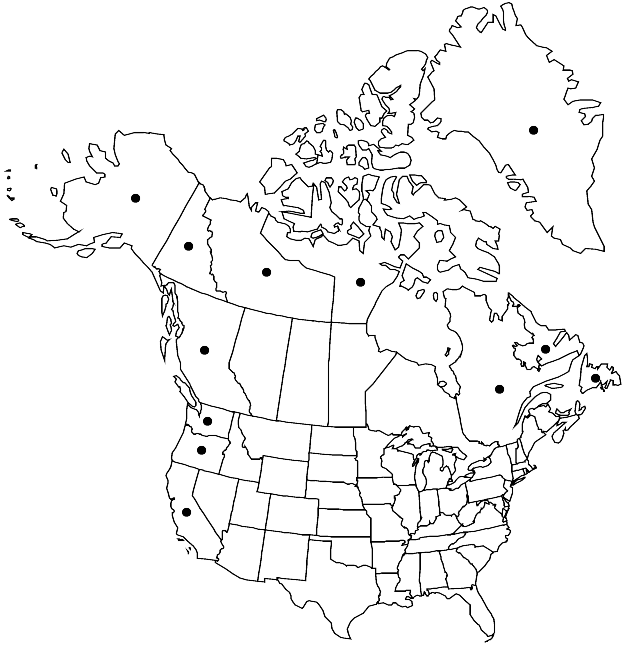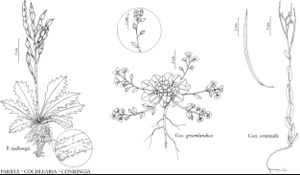Difference between revisions of "Cochlearia groenlandica"
Sp. Pl. 2: 647. 1753.
FNA>Volume Importer |
FNA>Volume Importer |
||
| Line 76: | Line 76: | ||
|publication year=1753 | |publication year=1753 | ||
|special status= | |special status= | ||
| − | |source xml=https://jpend@bitbucket.org/aafc-mbb/fna-data-curation.git/src/ | + | |source xml=https://jpend@bitbucket.org/aafc-mbb/fna-data-curation.git/src/f6b125a955440c0872999024f038d74684f65921/coarse_grained_fna_xml/V7/V7_810.xml |
|tribe=Brassicaceae tribe Cochlearieae | |tribe=Brassicaceae tribe Cochlearieae | ||
|genus=Cochlearia | |genus=Cochlearia | ||
Revision as of 21:24, 24 September 2019
Biennials or perennials. Stems usually few to several from base, rarely simple, erect to decumbent, branched distally, (0.1–)0.5–3(–4) dm. Basal leaves rosulate; petiole (0.2–)1–7(–10) cm; blade deltate to ovate, (0.3–)0.7–2(–2.5) cm × (2–)5–20 mm, base cuneate or truncate, margins entire, repand, or obscurely dentate, apex obtuse. Cauline leaves petiolate (shortly petiolate or sessile distally); blade 0.4–2 cm × 1–15 mm, base cuneate (not auriculate), margins entire, repand, or slightly dentate, apex acute. Racemes many-flowered. Fruiting pedicels divaricate to ascending, rarely erect, (2–)5–15(–20) mm. Flowers: sepals ovate or oblong, 1–2(–3) × 0.5–1.5 mm; petals oblanceolate to spatulate, 2–4(–5) × (0.5–)0.8–2(–3) mm; filaments 1–2(–2.5) mm; anthers 0.2–0.3 mm. Fruits ovoid to ellipsoid or obovoid, 3–6(–7) × 2–4(–5) mm, terete or slightly angustiseptate; valves usually not or obscurely reticulate, rarely distinctly so; septum complete or fenestrate; ovules 8–14 per ovary; style 0.1–0.4 mm. Seeds brown, ovoid to subglobose, 1–1.5 × 0.8–1.3 mm, papillate. 2n = 14.
Phenology: Flowering Jun–Aug.
Habitat: Tidal flats, beaches, dunes, lagoons, stream banks, seepage, peat hammocks, meadows, herb mats, tundra, maritime rocky beaches and slopes, bare areas of polygons, mud flat bird nesting sites
Elevation: 0-100 m
Distribution

Greenland, B.C., Nfld. and Labr., N.W.T., Nunavut, Que., Yukon, Alaska, Calif., Oreg., Wash.
Discussion
R. C. Rollins (1993) treated the North American plants with 2n = 14 as members of Cochlearia officinalis. That species is a strictly European tetraploid with 2n = 24. In our opinion, plants of the arctic and subarctic C. groenlandica complex represent an evolutionary lineage with x = 7, which is entirely distinct from that including the European C. officinalis and its relatives with x = 6. The systematic relationships of the x = 7 group to the 2n = 14 Icelandic plants of the C. pyrenaica complex are still unresolved.
The North American plants are extremely variable in flower size, petal shape, and fruit shape and size. They are much in need of detailed cytological, morphological, and molecular studies.
Cochlearia groenlandica is known in California from nesting areas on off-shore rocks in Del Norte County; in Oregon it occurs on ocean bluffs in Coos and Curry counties (A. Liston, pers. comm.). It appears to be naturally occurring in both states.
Selected References
None.
